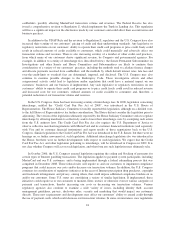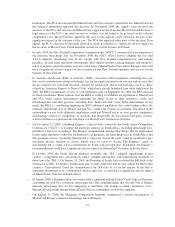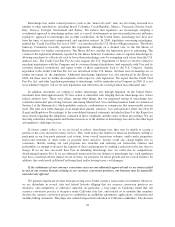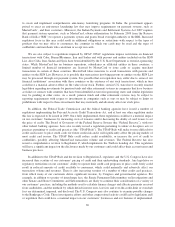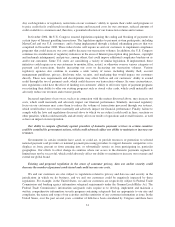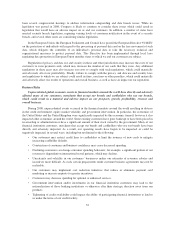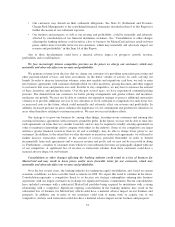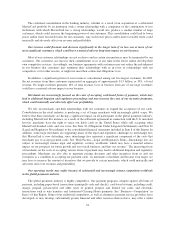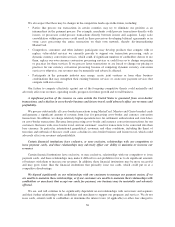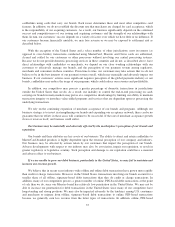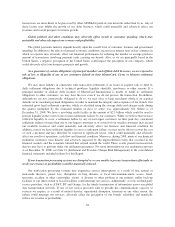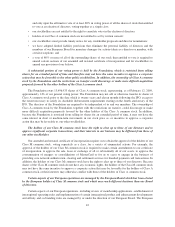MasterCard 2008 Annual Report Download - page 44
Download and view the complete annual report
Please find page 44 of the 2008 MasterCard annual report below. You can navigate through the pages in the report by either clicking on the pages listed below, or by using the keyword search tool below to find specific information within the annual report.The continued consolidation in the banking industry, whether as a result of an acquisition of a substantial
MasterCard portfolio by an institution with a strong relationship with a competitor or the combination of two
institutions with which MasterCard has a strong relationship, would also produce a smaller number of large
customers, which could increase the bargaining power of our customers. This consolidation could lead to lower
prices and/or more favorable terms for our customers. Any such lower prices and/or more favorable terms could
materially and adversely affect our revenue and profitability.
Our revenue could fluctuate and decrease significantly in the longer term if we lose one or more of our
most significant customers, which could have a material adverse long-term impact on our business.
Most of our customer relationships are not exclusive and in certain circumstances may be terminated by our
customers. Our customers can reassess their commitments to us at any time in the future and/or develop their
own competitive services. Accordingly, our business agreements with customers may not reduce the risk inherent
in our business that customers may terminate their relationships with us in favor of relationships with our
competitors, or for other reasons, or might not meet their contractual obligations to us.
In addition, a significant portion of our revenue is concentrated among our five largest customers. In 2008,
the net revenues from these customers represented an aggregate of approximately $1.5 billion, or 30%, of total
revenue. No single customer generates 10% of total revenue. Loss of business from any of our large customers
could have a material adverse impact on our business.
Merchants are increasingly focused on the costs of accepting card-based forms of payment, which may
lead to additional litigation and regulatory proceedings and may increase the costs of our incentive programs,
which could materially and adversely affect our profitability.
We rely on merchants and their relationships with our customers to expand the acceptance of our cards.
Consolidation in the retail industry is producing a set of larger merchants with increasingly global scope. We
believe that these merchants are having a significant impact on all participants in the global payments industry,
including MasterCard. For instance, as a result of the settlement agreement in connection with the U.S. merchant
lawsuit, merchants have the right to reject our debit cards in the United States while still accepting other
MasterCard-branded cards, and vice versa. See Note 18 (Obligations Under Litigation Settlements) and Note 20
(Legal and Regulatory Proceedings) to the consolidated financial statements included in Item 8 of this Report. In
addition, some large merchants are supporting many of the legal and regulatory challenges to interchange fees
that MasterCard is now defending, since interchange fees represent a significant component of the costs that
merchants pay to accept payment cards. See “Risk Factors—Legal and Regulatory Risks—Interchange fees are
subject to increasingly intense legal and regulatory scrutiny worldwide, which may have a material adverse
impact on our prospects for future growth and our overall business, and thus our revenue.” The increasing focus
of merchants on the costs of accepting various forms of payment may lead to additional litigation and regulatory
proceedings. Merchants are also able to negotiate pricing discounts and other incentives from us and our
customers as a condition to accepting our payment cards. As merchants consolidate and become even larger, we
may have to increase the amount of incentives that we provide to certain merchants, which could materially and
adversely affect our revenues and profitability.
Our operating results may suffer because of substantial and increasingly intense competition worldwide
in the global payments industry.
The global payments industry is highly competitive. Our payment programs compete against all forms of
payment, including paper-based transactions (principally cash and checks), card-based systems, including credit,
charge, prepaid, private-label and other types of general purpose and limited use cards, and electronic
transactions such as wire transfers and Automated Clearing House payments. See “Business—Competition” in
Item 1 of this Report. Some of our traditional competitors, as well as alternative payment service providers, have
developed, or may develop, substantially greater financial and other resources than we have, may offer a wider
34


